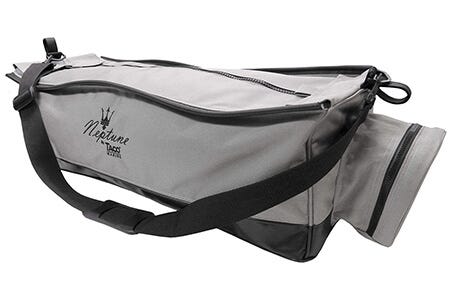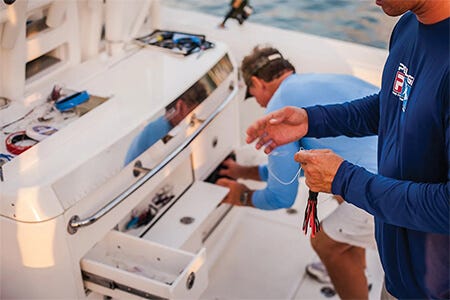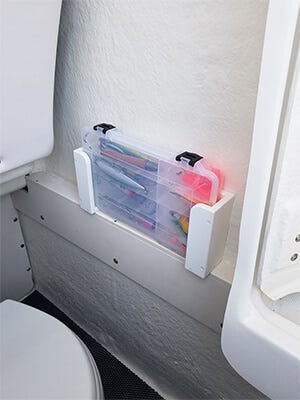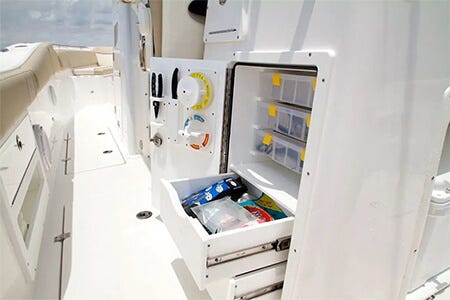

Not so long ago, a tackle box was a tackle box — an opaque plastic box with a hinged lid, a few divided trays that would cantilever out when the lid was opened, and an open area at the bottom for bigger stuff like line spools and pliers. You could buy them bigger or smaller, but the basic design didn’t vary much.
Contents
Considerations for Choosing the Best Tackle Box
Now, though, there are all kinds of different tackle storage options: conventional hard tackle boxes like grandpa’s, satchel-style two-sided hard boxes, soft-sided tackle bags, tackle backpacks and chest packs, kayak-specific tackle boxes, built-in boat tackle boxes, and many more.
So what are the best tackle boxes for your style of fishing? Rather than looking at specific models, let’s talk about which type of quality tackle box works best for which styles of fishing and why. We’ll also look at some other special considerations that should go into choosing the perfect tackle box.
Modular Tackle Systems vs. Conventional Tackle Boxes
One of the first things you need to decide is whether you want a modular system or a conventional tackle box.
Modular Tackle Boxes
A modular system consists of a box, bag, or pack designed to hold smaller plastic containers. The containers are usually flat plastic trays, like those made by Plano and Flambeau. A modular tackle system allows you to switch out the individual trays.
So you could put trays full of bass gear in one day and trout gear the next day. The boxes or bags that contain the trays usually have their own storage areas too, for larger items like pliers and lines. Modular tackle systems are more versatile than conventional boxes, but they also tend to be more expensive.
Conventional Tackle Boxes
Conventional tackle boxes don’t have interchangeable trays, which is just fine for many anglers. They are available in a variety of sizes to accommodate the basics up to a full complement of tackle. Conventional hard tackle boxes tend to be more affordable and straightforward than modular systems and are a great choice for novice anglers.
Tackle Bags for Bass Anglers
Bass anglers tend to carry more lures of different kinds and in more different colors than anybody else. But they often have no need for all of their tackle on any given day. For example, in cooler conditions, there’s little need for topwater lures, and in muddy water, there’s little need for certain lure colors that are better suited to clear water. That means modular tackle systems are ideal — especially duffel-style soft-sided bags.
Soft-Sided Tackle Bags
To pick the best soft-sided tackle bag for you, first consider how much storage you need. Some smaller tackle bags might hold only two to four 3600-size tackle trays. Larger bags might hold as many as 10 or 12 of the larger 3700-size trays. You want to have plenty of room for your tackle, but you also don’t want a bigger bag than you actually need. Bigger bags are harder to carry and take up extra space on the boat.
To pick the best soft-sided tackle bag for you, first consider how much storage you need.
Also, look at what kind of built-in storage a tackle bag offers in addition to the removable tackle trays. If you need to keep bulky items like spools of line or leader, fish grips, culling tags, bottles of scent, bags of soft plastics, etc. make sure to get a bag with large, deep pockets. On the other hand, if you normally fish from your own boat and keep those larger items in separate compartments, you may want to go with a slimmer bag with less built-in storage.
Best Lure-Specific Tackle Storage Options
Certain kinds of lures are much easier to manage when stored in specially designed containers. Jigs, crankbaits, long stickbaits with multiple treble hooks, and even some soft plastic lures don’t fit well into general-purpose tackle boxes or trays.
One of the new trends in tackle management is containers specifically for certain lure types. For example, Gruv has developed an innovative line of specialized tackle storage solutions, including boxes for large jigs, small jigs, and hard baits, while Plano has numerous specialty boxes in its new EDGE lineup, including for swimbaits, bladed jigs, spinner baits, frog lures and bullet weights. These boxes keep lures from getting tangled together, make them easier to see, and protect them from damage.
Best for Soft-Plastics
For soft plastics like worms, flukes, Senkos, and paddletails, the best storage choice is often the sealed plastic bags they come in. Some plastic lure formulations will “melt” other plastic lures or even damage tackle boxes. Plus, plastic soft baits tend to collect debris and dirt and even dry out if stored outside a sealed bag. That means you’ll want a box or container sized to efficiently hold bags of plastic lures.
Plano and Flambeau Tackle Tray Sizes and Options
Modular plastic tackle boxes and trays like those popularized by Plano are made in hundreds of different sizes and configurations, often denoted by a number, like 3730. It can be very confusing to figure out what you need. Here’s what you need to know to get started:
Two Basic Footprints
There are a few fairly standard “footprints” that are more or less the same across manufacturers. The majority of tackle bags, backpacks, modular boxes, and even built-in boat tackle cabinets are designed around either “3600-series” or “3700-series” trays. Those are actually Plano names, but they have come to mean any manufacturer’s tray of the same size.
A Plano 3600-series tray is roughly 10-3/4” x 7-1/4”. A 3700-series tray is roughly 14” x 9”.
In Flambeau trays, models starting with a 4, e.g., 4007 correspond to Plano’s 3600 size, while models starting with a 5 correspond to the 3700 size. Bass Pro shops just call them “360” and “370,” respectively. The important thing is that there are basically two size tackle trays for use with most bags and boxes: 10-3/4” x 7-1/4” and 14” x 9”.
Depths & Configurations
Within those two basic footprints, there are several different depths and hundreds of different configurations. Most soft tackle bags can accommodate trays of various depths as long as they have the right footprint. Many hard tackle boxes and built-in boat tackle boxes, though, have slots designed for a certain height, so measure before buying trays for them.
Some boxes have a combination of fixed dividers, adjustable dividers, and removable dividers, others have all fixed dividers, and still, others have no dividers at all. There are also waterproof trays and trays with integrated rust inhibitors.
Many companies also make smaller tackle trays. Plano, for example, makes both a 3400 and 3500 series.
The 3400 series is just 6-1/2” x 3-3/4” and works well for holding a few smaller crankbaits, inline spinners, or weights and hooks.
The 3500 series is 9” x 5”, providing a bit more room. Both smaller sizes are well suited for use in small tackle backpacks, chest packs, and waist packs or for tucking in a pocket of your jacket or waders.
Best Kayak Tackle Boxes
Kayak tackle boxes have a few special requirements. First, they need to fit into the cargo area of a typical fishing kayak. That tends to make them taller and narrower, on average, than other tackle boxes. They also need to be waterproof and close securely so your tackle will stay dry and in your kayak in the event of rough water or a capsize. Note that the outer box doesn’t necessarily need to be waterproof, but if it isn’t, the trays should be.
Ease of access is critical since kayak tackle boxes are typically located behind the seat.
Ease of access is critical since kayak tackle boxes are typically located behind the seat. Because you’re twisting around behind you to reach your tackle, you want something easy and quick to open. Integrated vertical rod storage is also an important feature.
Best Built-In Boat Tackle Boxes
For many boat owners, there’s little need for a portable tackle box. It makes more sense to simply store their tackle aboard the boat.
Of course, it can be stored in a regular compartment or locker, but a dedicated tackle box, tackle cabinet, or tackle center provides lots of advantages.
A good boat tackle center keeps tackle secure in rough conditions, provides dedicated areas for commonly used gear like pliers and knives, and makes tackle easy to access. Locking tackle cabinets also provide extra security for leaving gear on board.
A good boat tackle center keeps tackle secure in rough conditions, provides dedicated areas for commonly used gear, & makes tackle easy to access.
Just as with a tackle bag, when choosing the best permanent boat tackle box for you, consider just how much gear you’ll need. Some tackle centers can accommodate a dozen or more tackle trays plus lots more gear in drawers and open bins. Will you need room for large spools of line, marker buoys, reels, or other bulky items?
The maximum size will also be dictated by the mounting area. But remember that with modular trays, you can swap out fishing accessories based on what kind of fishing you’ll be doing on a given day. You don’t necessarily have to fit all your tackle at once.
Types of Tackle Centers
Keep in mind too that there are several different types of boat tackle centers. Inset tackle boxes are mounted in a cutout in a vertical surface. Most of the box itself is behind the mounting surface; only the door and frame are visible. These work well for mounting in the walls of consoles and bulkheads.
Freestanding tackle centers are normally attached to the deck, but can also be mounted through the top to the underside of a leaning post or similar structure.
Tilt-out tackle boxes are inset behind the mounting surface, but instead of a cabinet-style door, they tilt open from the top, requiring less depth behind the mounting surface.
Surface-mount tackle tray holders are also available and can be mounted permanently or temporarily on almost any vertical surface.
Tackle Centers for Bass Boats
For bass boat owners, a drop-in tackle organizer can make the typical centerline forward tackle locker neater and more accessible. With a range of innovative features, including a sliding, removable quick-access storage tray for plastics and other commonly used items, the Boat Outfitters Center Tackle Organizer is the best bass boat tackle storage solution available. The organizer is currently available to fit the Nitro Z20 tackle locker, but a version for other popular boats is in the works.




